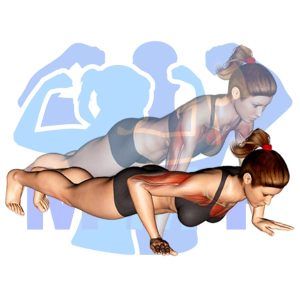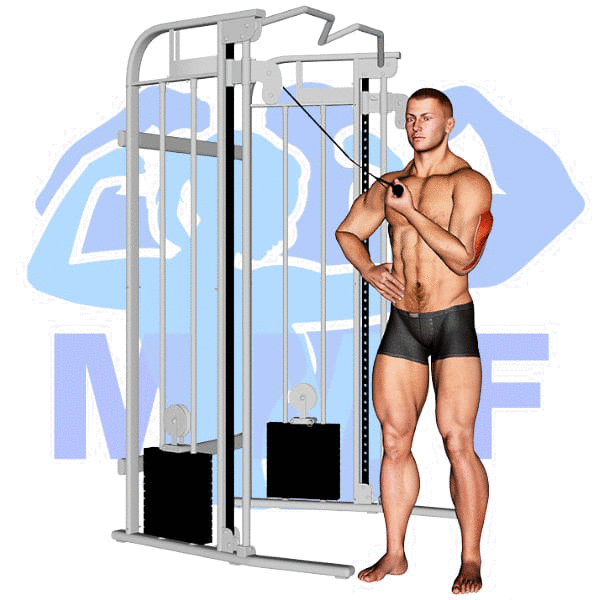Are you tired of feeling like your back workouts aren’t effective? Maybe you’ve struggled to build muscle in your upper back or experienced discomfort during certain exercises. One solution to these problems could be utilizing the t bar supported reverse grip row. It’s not uncommon to struggle with isolation exercises for the back, and the muscles targeted by this exercise can be difficult to engage without proper form or support. In this post, we’ll dive into the benefits of the t bar supported reverse grip row and provide tips for perfecting your form to optimize your back workouts. With this knowledge, you’ll be on your way to seeing improvements in your back muscles and feeling stronger during your routines.
T Bar Supported Reverse Grip Row Summary
- Primary Muscles: Deltoid – Posterior
- Secondary Muscles: Brachialis, Brachioradialis, Infraspinatus, Latissimus Dorsi, Rhomboids, Teres Minor, Trapezius – Lower, and Trapezius – Middle
- Equipment: T-Bar
- Mechanics Type: Compound
- Force: Pull
- Utility: Basic

T Bar Supported Reverse Grip Row Instructions
- Grip the barbell with an overhand, shoulder-width grip.
- Position the barbell close to your body and slightly above your knees.
- Keep your back straight and core tight.
- Pull the barbell towards your upper abdomen, squeezing your shoulder blades together at the top of the movement.
- Lower the barbell under control until your arms are straight.
- Repeat for desired repetitions.
Video Tutorial
T Bar Supported Reverse Grip Row Muscles
Target (Agonist)
Synergists
- Brachialis
- Brachioradialis
- Infraspinatus
- Latissimus Dorsi
- Rhomboids
- Teres Minor
- Trapezius – Lower
- Trapezius – Middle
Dynamic Stabilizers
- Biceps Brach
Stabilizers
Antagonist Stabilizers

Benefits of T Bar Supported Reverse Grip Row
The T Bar Supported Reverse Grip Row is a great exercise to include in your strength training or fitness routine. This exercise targets the posterior deltoid muscle, which is important for shoulder stability and overall shoulder health. Performing this exercise will help to strengthen the posterior deltoid and improve your posture. Additionally, this exercise also engages the rhomboids, trapezius, and biceps, making it an effective full-body workout. When performed correctly, the T Bar Supported Reverse Grip Row can help improve your strength and overall performance.
Tips for Performing T Bar Supported Reverse Grip Row
When performing the T Bar Supported Reverse Grip Row, it is important to be mindful of proper form and technique in order to reap the full benefits of this exercise. Below are some helpful tips to keep in mind when doing this exercise to make sure you are maximizing your efforts and seeing the results you want.
- Maintain a Neutral Spine: It is important to keep the back flat and in a neutral position while performing the exercise, rather than arching or rounding the back. This will help to ensure that the muscles of the back are adequately engaged and prevent injury.
- Keep the Shoulders Down and Back: The shoulders should be kept down and back throughout the exercise to ensure proper alignment of the shoulder joints and to prevent any injuries from occurring.
- Engage the Core Muscles: It is important to engage the core muscles throughout the exercise in order to stabilize the body and to ensure that the movement is being performed with correct form. This will help to maximize results and reduce any risk of injury.
Benefits and Tips Video
Frequent Mistakes To Avoid
It is important to pay attention to your form when performing the T Bar Supported Reverse Grip Row to ensure you are getting the most out of the exercise and avoiding any potential injuries. Below, we will discuss some common mistakes that should be avoided when doing this exercise.
- Not using proper form: Maintaining the correct form is essential to get the best results from this exercise. Keep your back and neck straight while keeping your shoulders down and chest out. Do not round your back or let your head drop forward, as this can lead to injury.
- Not keeping your elbows tucked: Keeping your elbows tucked close to your body as you pull the weight towards you will maximize the benefits of the exercise. Allowing them to flare out to the side puts too much strain on your shoulder joints and reduces the effectiveness of the exercise.
- Using too much weight: Using too much weight can lead to poor form and potentially cause injury. Start with a light weight and gradually increase it as you become more comfortable with the exercise. Make sure you are in control of the weight throughout the entire movement and are able to keep proper form.
Find More Machine Exercises Here
Variations and Complementary Exercises
There are several variations, complementary, or alternative exercises that can be used in place of the T Bar Supported Reverse Grip Row. These exercises may be used to target the same muscle groups as the T Bar Supported Reverse Grip Row, and can be used to switch up your routine or to provide a different challenge. The following list includes some of the variations, complementary, and alternative exercises that can be used in place of the T Bar Supported Reverse Grip Row:
Band Rear Deltoid Row

Band Rear Deltoid Row is a great complementary or alternative exercise to the T Bar Supported Reverse Grip Row. This exercise is performed with an exercise band that is securely attached to a post or sturdy object at waist level. You will stand with one foot on the band and grab the other end of the band with the opposite hand. The goal is to pull the band up to your chest, focusing on contracting your rear delts. This exercise helps build strength and stability in your rear deltoids, which is especially important for maintaining good posture and preventing injury during activities such as lifting or pushing.
Barbell Rear Delt Raise

The Barbell Rear Delt Raise is a great complementary exercise for the T Bar Supported Reverse Grip Row. It is an isolation exercise that specifically targets the posterior deltoid muscles, giving you greater strength and definition in your upper back. To perform this exercise, stand with your feet shoulder-width apart and hold a barbell with a wide, pronated grip. Raise the barbell up to shoulder level, keeping your arms straight and your elbows slightly bent. Lower the weight slowly, controlling the descent and feeling the muscles in your upper back working. The Barbell Rear Delt Raise is a great alternative to the T Bar Supported Reverse Grip Row, providing an effective way to target the posterior deltoid muscles.
Barbell Skier

Barbell Skier is a great exercise for those looking for an alternative or complementary exercise to the T Bar Supported Reverse Grip Row. This exercise is performed by holding a barbell with a wide grip and performing an explosive squatting motion. This exercise works the quads, glutes, hamstrings and core muscles, as well as the upper back and shoulders. It is great for improving overall strength and power, as well as providing a full body workout. It can be used as an alternative to the T Bar Supported Reverse Grip Row, as it works similar muscle groups but in different ways.
Check Out These Top Machine Exercises
Cable Rope Face Pull

The cable rope face pull is a great alternative or complementary exercise to the T bar supported reverse grip row. This exercise focuses on the muscles of the upper back and shoulders while targeting the posterior deltoids, traps, rhomboids, and biceps. The cable rope face pull is a great way to develop strength and stability in the muscles of the upper back and shoulders. Additionally, this exercise can help with posture and reduce the risk of injury in other exercises.
Inverted Rows

Inverted Rows are a great complementary or alternative exercise for the T Bar Supported Reverse Grip Row. This bodyweight exercise is performed by suspending oneself from a bar and pulling the body up toward it. It’s an excellent way to strengthen the back muscles and improve posture. Inverted Rows are also a great way to increase grip strength and build core stability. To make the exercise more challenging, one can adjust their body angle or add weight plates. The movement is similar to the T Bar Supported Reverse Grip Row, however, since it’s done without any weight, it’s much less intimidating and requires less skill to perform.
Reverse Fly With Bands

Reverse Fly With Bands is a great complementary or alternative exercise to the T Bar Supported Reverse Grip Row. This exercise targets the rear deltoids, rhomboids, and trapezius muscles, while also engaging the core and upper back muscles. This exercise can be performed using resistance bands and requires a stable surface to anchor them. Starting in a standing position with feet hip-width apart and arms extended, pull the handles of the band out to the sides until your arms are parallel with the floor and then slowly return to starting position. This exercise can help build strength and improve posture, making it a great addition to any upper body routine.
Find More Back Exercises Here
Opposing Complementary Exercises
To make sure you’re giving your muscles a complete workout, try incorporating these exercises that work the opposing muscle groups to the exercise T Bar Supported Reverse Grip Row. These exercises will help you create a balanced workout and give your body the best chance to grow.
Incline Push Up

The incline push up is a great complement to the T Bar Supported Reverse Grip Row. This push up exercise targets the chest muscles while the T Bar Reverse Grip Row focuses on strengthening the back muscles. By doing both exercises, you can create a balanced workout that will help develop both muscle groups. The incline push up places emphasis on the upper chest muscles and helps to build strength, stability and balance. Additionally, it helps to develop core strength and stability as well as increase endurance. By doing both exercises together, you can effectively strengthen both your chest and back muscles.
Narrow Push Up

The Narrow Push Up is a great complementary exercise to the T Bar Supported Reverse Grip Row. It targets the opposing muscle groups of the back, chest and arms. The Narrow Push Up focuses on building the strength of the triceps, anterior deltoids and pectoral muscles. It works on improving the stability and strength of the upper body while also helping to develop core stability. This exercise helps to create balance between the opposing muscle groups by strengthening both the back and chest muscles. This helps to ensure that no one muscle group is over or under developed.
Push Up

The push up is a great complementary exercise to the T Bar Supported Reverse Grip Row, as it works the opposing muscle group. Push ups are a great upper body exercise that works the chest, triceps, and shoulders. It is an efficient movement that can be done anywhere with no equipment. The pushing motion of the push up works the chest, triceps and shoulders in an opposite direction to the pulling motion of the T Bar Supported Reverse Grip Row, which works the back and biceps. By combining these two exercises, you can effectively work both sets of muscles for an all-round workout.
Row Your Way To A Stronger Back!
A strong back is essential for good posture and overall strength. A great way to develop a strong back is by incorporating rowing exercises into your workout routine. Not only do these exercises target the back muscles, but they can also improve grip strength and provide a full-body workout. The T-bar supported reverse grip row is one such exercise that targets the upper back, biceps, and forearms, making it an effective addition to any workout routine. With proper form and consistent training, you can row your way to a stronger and healthier back.
References: Wikipedia | ExRx.net | PubMed.gov | Comprehensive List of Back Machine Exercises




